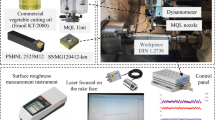Abstract
Minimum quantity lubrication (MQL) technique has been widely used in different machining processes. However, oil mist discharged from MQL system induces negative effects for working space. In this paper, a continuous MQL system with ultrasonic vibration (U-CMQL) is proposed for near dry machining process. A valve-less micro-pump is designed to supply continuous lubrication to the cutting edge without making oil mist. Penetration mechanism of micro lubrication in ultrasonically assisted machining (UAM) process is firstly analyzed. Experiments are carried out to study the influence of dry machining, ultrasonically assisted machining, and U-CMQL machining on turning performance of Ti–6Al–4V alloy. Cutting force, tool wear, surface roughness, and chip morphology are experimentally analyzed. The results show that U-CMQL technique not only maintains neat working area but also improves the machinability characteristics to some extent. In comparison with dry machining and ultrasonically assisted machining, U-CMQL shows lower cutting force and tool wear rate due to the combined advantages of lubrication and vibration. Moreover, short tool-chip contact length, favorable chip morphology, and better surface integrity are obtained under U-CMQL machining.
Similar content being viewed by others
References
Sharif MN, Pervaiz S, Deiab I (2017) Potential of alternative lubrication strategies for metal cutting processes: a review. Int J Adv Manuf Technol 89(5–8):2447–2479
Sharma VS, Dogra M, Suri N (2009) Cooling techniques for improved productivity in turning. Int J Mach Tools Manuf 49(6):435–453
Gunter KL, Sutherland JW (1999) An experimental investigation into the effect of process conditions on the mass concentration of cutting fluid mist in turning. J Clean Prod 7:341–350
NIOSH (1998) Recommendation for a metalworking fluids standard. http://www.cdc.gov/NIOSH/(Chapter1)
Duchosal A, Werda S, Serra R, Leroy R, Hamdi H (2015) Numerical modeling and experimental measurement of MQL impingement over an insert in a milling tool with inner channels. Int J Mach Tools Manuf 94:37–47
Yoon SS, Desjardin PE, Hewson JC, Aveldisian CT (2006) Numerical modeling and experimental measurements of water spray impact and transport over a cylinder. Int J Multiphase Flow 32(1):132–157
Duchosal A, Leroy R, Vecellio L, Louste C, Ranganathan N (2013) An experimental investigation on oil mist characterization used in MQL milling process. Int J Adv Manuf Technol 66(5–8):1003–1014
Maruda RW, Krolczyk GM, Feldshtein E, Pusavec F, Szydlowski M, Legutko S, Kupiec AS (2016) A study on droplets sizes, their distribution and heat exchange for minimum quantity cooling lubrication (MQCL). Int J Mach Tools Manuf 100:81–92
Aoyama T, Kakinuma Y, Yamashita M, Aoki M (2008) Development of a new lean lubrication system for near dry machining process. CIRP Ann Manuf Technol 57(1):125–128
Williams JA, Tabor D (1977) The role of lubricants in machining. Wear 43(3):275–292
Claudin C, Mondelin A, Rech J, Fromentin G (2010) Effects of a straight oil on friction at the tool–work material interface in machining. Int J Mach Tools Manuf 50(8):681–688
Muhammad R, Hussain MS, Maurotto A, Siemers C, Roy A, Silberschmidt VV (2014) Analysis of a free machining α+β titanium alloy using conventional and ultrasonically assisted turning. J Mater Process Technol 214(4):906–915
Brehl DE, Dow TA (2008) Review of vibration-assisted machining. Precis Eng 32(3):153–172
Nath C, Rahman M (2008) Effect of machining parameters in ultrasonic vibration cutting. Int J Mach Tools Manuf 48(9):965–974
Zhang C, Guo P, Ehmann KF, Li YG (2016) Effects of ultrasonic vibrations in micro-groove turning. Ultrasonics 67:30–40
Khan M, Mithu M, Dhar NR (2009) Effects of minimum quantity lubrication on turning AISI 9310 alloy steel using vegetable oil-based cutting fluid. J Mater Process Technol 209(15):5573–5583
Su Y, Gong L, Li B, Liu ZQ, Chen DD (2016) Performance evaluation of nanofluid MQL with vegetable-based oil and ester oil as base fluids in turning. Int J Adv Manuf Technol 83(9–12):2083–2089
Zhang RH, Zhang LJ, Hu XQ, Chen XY (2016) Experimental study on flow characteristics of valve-less piezoelectric pump with triangular prism bluff bodies. J Vib Meas Diag 36(3):580–585
Gajrani KK, Ram D, Sankar MR (2017) Biodegradation and hard machining performance comparison of eco-friendly cutting fluid and mineral oil using flood cooling and minimum quantity cutting fluid techniques. J Clean Prod 165:1420–1435
Da Silva RB, Machado AR, Ezugwu EO, Bonney J, Sales WF (2013) Tool life and wear mechanisms in high speed machining of Ti–6Al–4V alloy with PCD tools under various coolant pressures. J Mater Process Technol 213(8):1459–1464
Lotfi M, Amini S (2017) Experimental and numerical study of ultrasonically-assisted drilling. Ultrasonics 75:185–193
Ulutan D, Ozel T (2011) Machining induced surface integrity in titanium and nickel alloys: a review. Int J Mach Tools Manuf 51(3):250–280
Funding
This study received funding from the “Fundamental Research Funds for the Central Universities (500418785)”.
Author information
Authors and Affiliations
Corresponding author
Rights and permissions
About this article
Cite this article
Yan, L., Zhang, Q. & Yu, J. Effects of continuous minimum quantity lubrication with ultrasonic vibration in turning of titanium alloy. Int J Adv Manuf Technol 98, 827–837 (2018). https://doi.org/10.1007/s00170-018-2323-0
Received:
Accepted:
Published:
Issue Date:
DOI: https://doi.org/10.1007/s00170-018-2323-0




